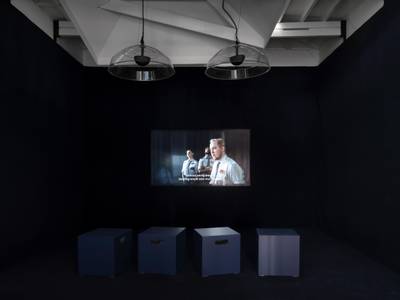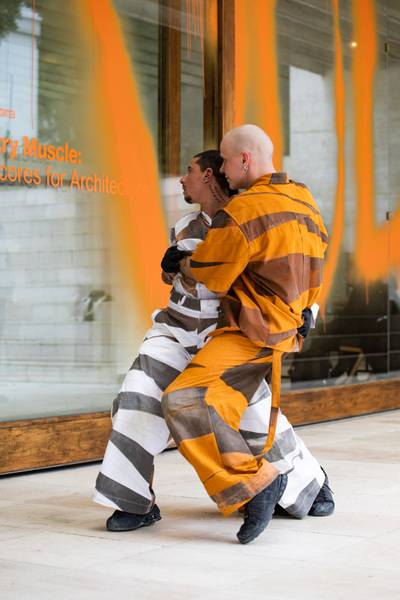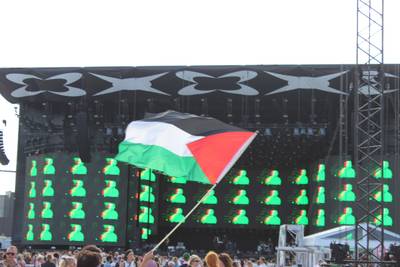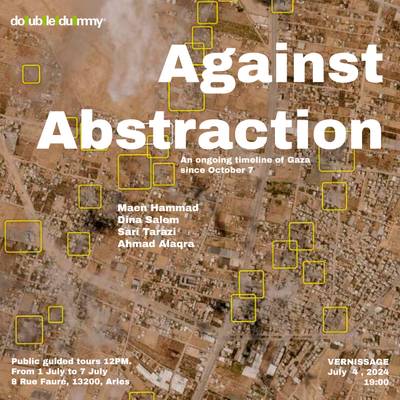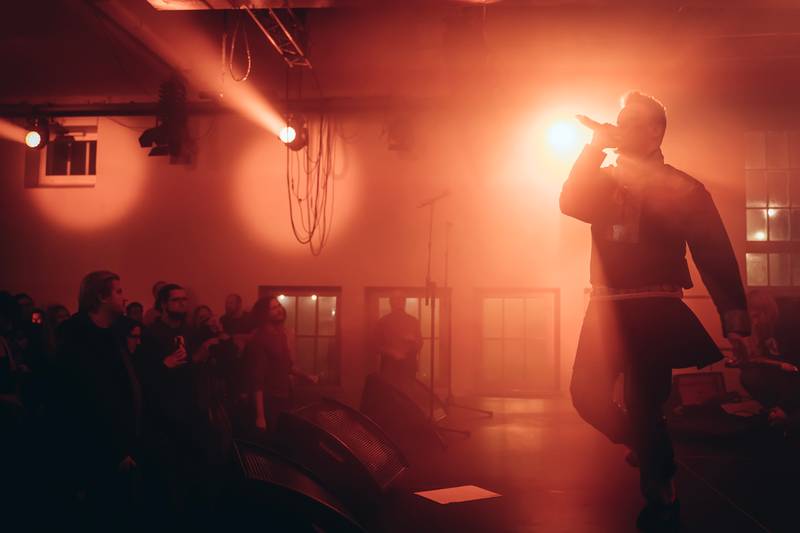

Ailu Valle at the beginning of the club night
Hector Sanchez (he/him/él) is a Mexican anthropologist who has been building his career, empathy, and critical thinking on a transnational journey. Having been living in Mexico, Ireland, India, and Finland, he specialized in the fields of Indigenous Studies, Interethnic Conflicts, Contemporary Music, and more recently, Hip hop Studies. He is currently interested in inquiring the value of subaltern contemporary music for Indigenous peoples and how they shape the global music market.
It is high time more events happened in Helsinki, led by Indigenous peoples. In this way, the venue naturally becomes a place of belonging, a place where attendees free themselves by just following their own rhythm while speaking up for care towards nature and acknowledging the need to have a night diverse in identities, languages, and musical traditions. On the first night of the Baltic Circle Festival (November 19, 2021), under a dark and rainy sky, Sámi rapper Ailu Valle and the Inuit DJ Uyarakq brought together a mixture of mutinous hip hop and dynamic electronic tunes that, together, questioned the industrial aggressive land use that we live in while still providing fun to a bouncy audience. In this way, they brought a performance that went from critical stances to dance movements, just the normal unleashing that Hip Hop provides. Held at Tiivistämö, the concert was part of a conceptual Vuostta álbmogat – klubba, a thematic club night concept on new Indigenous music that Baltic Circle has been running since 2017. Moving from one musical era to the next, social trauma caused by our global industrialized world was set aside to make the audience jump away from sorrows while critically questioning the inequalities that Indigenous and other marginalized communities face.
I consider this club concept to be very necessary for the live music scene in the city, as it was one of the few events happening in Helsinki this year led by Indigenous peoples, in the alternative Suvilahti, an area that houses different urban subcultures and expressions. Giving space in this way to voices of the margins, which is an aim of hip hop: bringing the margins to contemporary popular culture. In this way, the venue became a place of belonging, a place where attendees could free themselves by just following their own rhythm while speaking up for care towards nature, and acknowledging the need to have a night diverse in identities, languages, and music traditions.
A Brief History of Sámi Music
Hip hop has played a special role in this spectrum, by giving a voice to a younger generation that attempted to challenge the established canons of how to express “indigenous identity”.
To explain the character of the club night, I’d like to give a brief overview of Sámi music. The Sámi, an Indigenous people of Sápmi1, have mostly developed vocal sounding practices, with joik being the most widely spread musical tradition. In its most basic form, joik is a long-lasting vocal sound performed by a single person that serves as a means of recalling a location, a person, or any other element from a familiar environment. Musical expressions, particularly after land-right conflicts in Sápmi during the 1970s, became a key feature of political resilience among the Sámi youth (Hilder, 2012). In the 1960s, it was Nils-Aslak Valkeapää, a “cultural hero” who combined joiks with nature-based sounds and acoustic arrangements, who gave rise to a genre classified as “Sámi contemporary music”. (Hautala-Hirvioja, 2019). Since then, music from Sápmi has been reinventing itself, and today we can find a well-known music industry that includes a diverse range of contributors: from the DJ Article 3 collective’s feminist electronic beats to Sofia Jannok’s pop tunes, Mari Boine’s folk music, Ánnámáret’s pop-like joik songs, Intrigue’s heavy metal, and more. Hip hop has played a special role in this spectrum, by giving a voice to a younger generation that attempted to challenge the established canons of how to express “indigenous identity”.
Ailu Valle, the voice of the night, is a news anchor, voice actor, and rapper who performs in North Sámi, one of the three Sámi languages spoken in Finland (besides Inari Sámi and Skolt Sámi). Hailing from Gámasmohkki in Finnish Lapland, he is a pivotal figure in the evolution of hip hop in Sápmi. His music appeared on the map in 2012 with his debut album ‘Dušši dušše duššat’ (Useless just to be destroyed), followed by the records ‘7’ in 2015 and ‘Viidon Sieiddit’ (Sacred widened rocks) in 2019. His latest music project is a record in collaboration with Inari Sámi rapper Amoc, which is set to be released next year.
The club’s sounding character, Aqqalu Berthelsen aka Uyarakq, is a Greenlandic DJ based in Finland, who is mainly involved in the Indigenous Arctic circumpolar hip hop and rap ‘scene’. His latest release was the single ‘It’s Fricking Inuit Day’ (2021). Aside from being a music producer for various artists, he is a “party master” of playing Indigenous contemporary music at different alternative events primarily in Sápmi.
Ailu Valle’s music has one specific purpose: activism for his people. He says, “I do not follow categories, nor do I feel my music is only for a Sámi audience. I want to show everyone the resilience that we, the Sámi people, have had to endure to safeguard our own culture and territory, Sápmi.”
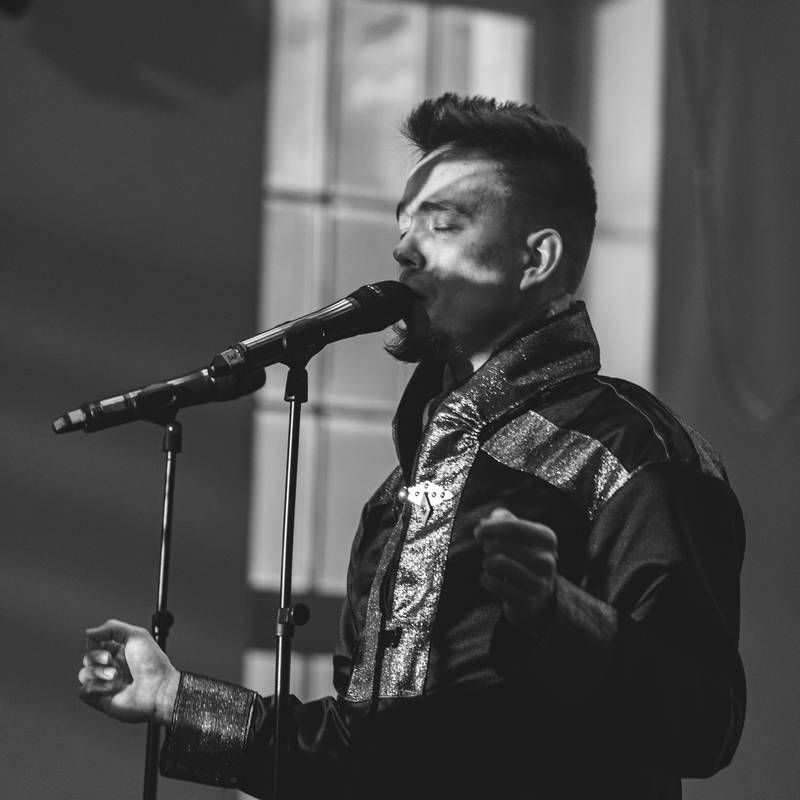

Ailu Valle while performing on stage
Social Demands Through Verses and Dance: Ailu Valle on Stage
Ailu Valle’s music has one specific purpose: activism for his people. He says, “I do not follow categories, nor do I feel my music is only for a Sámi audience. I want to show everyone the resilience that we, the Sámi people, have had to endure to safeguard our own culture and territory, Sápmi.” His thoughtful and long-lasting songs are not “catchy” hip hop tunes; rather they hold a dense background with riffs, long rhymes, and eventually stirring beats that intertwine with Ailu’s yawning voice. Energetic beats and environmental stewardship go hand in hand in his musical reflection. His music follows the objectives of hip hop as a way of life. He says, “It came easy for me to sing about Sámi environmental issues because hip hop is an activist movement and that is the nature of my music”2. His political stance was clear throughout the night as he repeatedly reminded the audience about the Sámi environmental struggle in Sápmi.
Valle interacted with the audience constantly, speaking in English and translating song titles so that many among the audience could get a sense of what they were hearing. Nonetheless, his fierce on-stage demeanor, which personifies the just Sámi demands, does not require translation. English became the communication bridge as Valle and Uyarakq aimed to create a shared space where Indigenous demands could be visualized by an audience that, perhaps, are not so familiar with their struggles. North Sámi, on the other hand, acquired a starring role as Valle narrated the context of each song every time he introduced their titles in this language.
The live collaboration demonstrated how hip hop can forge alliances among marginalized communities to visualize their struggles, particularly at the end of the song when Paleface exclaimed aloud “NO ARCTIC RAILWAY”, referring to current plans for a railway line that will connect northern Finland with the Norwegian Barents Sea harbor, a megaproject strongly condemned by the Sámi people.
The night began with the gloomy intro ‘Vuoiŋŋat’. With thundery sounds that blended with the darkness of the place, the spoken word that said: “Vuoiŋŋat ráfis, Ráfi vuoiŋŋat” or translated as “The Spirits in Peace, The Spirits of Peace”3 gave a glimpse of the serious yet energetic performance we were about to experience. Right after the intro, Valle went into his first piece named ‘Guovža lea lihkkan’, which was a stamina boost for the attendees as he began to jump around and ask the audience to raise their hands to the rhythm of this piece that awakened the dancefloor, much like a bear awakes from its sleep. In fact, that is the English translation of the song (Bear has awakened), which does justice to the sonic energy. The concert continued with ‘Ancestors’, his only English-language song. This one, in particular, was intriguing because of the sense of belonging it conveys, as it refers to human-to-human and human-to-other-than-human kinship. Later on, one of the most memorable moments of the night occurred when Valle invited none other than the Finnish rapper Paleface to the stage, who had shown up among the crowd and went onstage to sing their collaborative song ‘Jostain paljon kauempaa’. In a very dynamic interaction, the two invited the audience to chant while the joik voices of Nils-Aslak Valkeapää played in the background. The live collaboration demonstrated how hip hop can forge alliances among marginalized communities to visualize their struggles, particularly at the end of the song when Paleface exclaimed aloud “NO ARCTIC RAILWAY”, referring to current plans for a railway line that will connect northern Finland with the Norwegian Barents Sea harbor, a megaproject strongly condemned by the Sámi people.
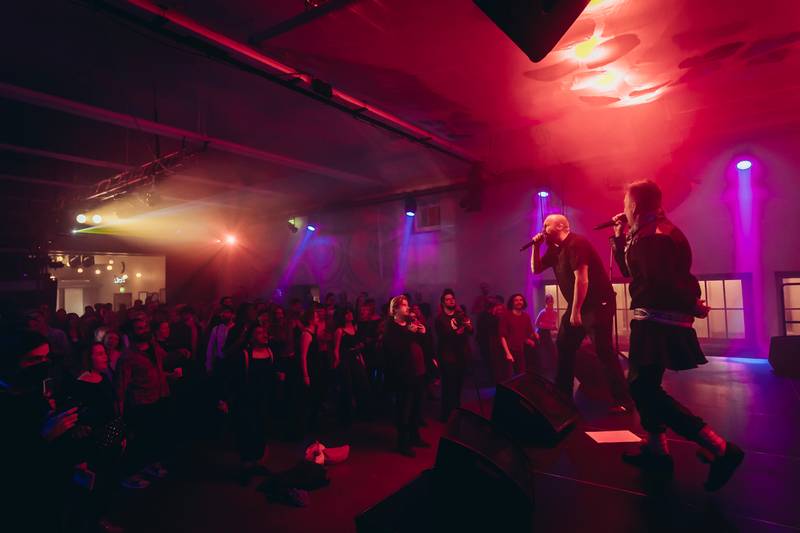

Paleface and Ailu Valle on stage
The repertoire continued with ‘Dušši dušše duššat’, a melancholy piece with a slower cadence than the rest of the repertoire, a song that tells the story of the degradation of the earth in a very dreamy narration. The song’s live performance was a mix of peaceful and lively, with Valle asking the audience to raise their hands while singing melancholy:
“ferte lahppot ahte livččii
manahit vai árvvoštivččii
áddet ahte beroštivččii
lea dušši dušše duššat”
“you have to disappear to exist
lose in order to value
understand in order to care
it is useless just to be destroyed”4
This song instilled calm in the audience as we neared the end of the concert and prepared to move on to the next stage of this ritual: the club night. ‘Dušši dušše duššat’ was followed by the song ‘Viidon Sieiddit’ (Sacred Widened Rocks), a song from the album of the same name. This piece reminded the audience of the magic that the earth holds by starting with a peaceful electronic sound, moving slowly to a spoken word by Valle that narrates the belonging feeling towards nature that Sámi people experience, just as many other Indigenous communities worldwide. Nonetheless, he told with this song that we all can be allies with nature and hearing Indigenous demands could be the first step.
After finishing their set, Valle and Uyarakq returned for an encore of two songs, the last of which was the dance-themed ‘Roryda’, a collaboration between Valle and the alternative music group Ylva, led by Sámi artist Niillas Holmberg. This song was a great way to end the night because it has mostly electronic beats that, when combined with some sombre joik jingles and Valle’s strong voice, allowed attendees to release their last burst of dancing adrenalin. The concert ended in a dark venue illuminated with reddish lights, awakened ancestors that pledged for a caress that could heal the social trauma that the aggressive land use has caused in recent times. Perhaps music could be the first step in this healing process.
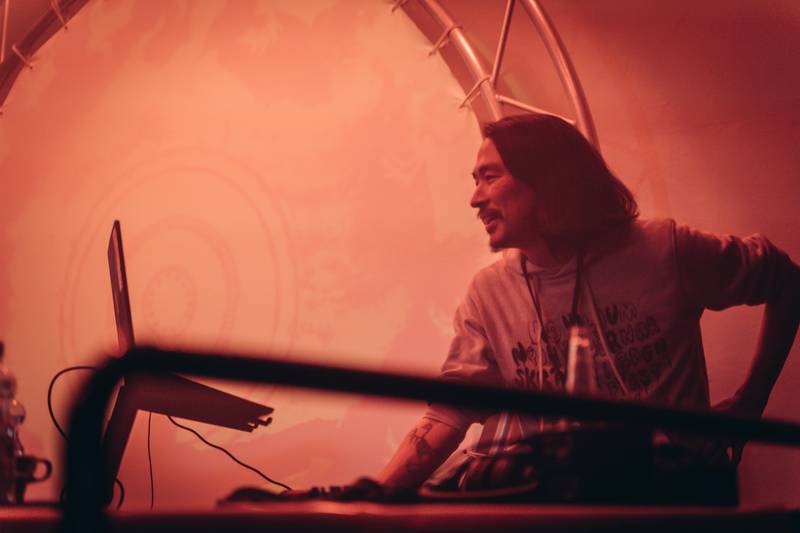

DJ Uyarakq on his role as a “party master”
Diverse Movements and How to Overcome Collective Sorrows: Dj Uyarakq on Stage
After the concert ended at midnight, the club night began with DJ Uyarakq, who mainly played songs by Indigenous artists remixed with electronic touches. Uyarakq’s music addresses various issues concerning Indigenous peoples’ colonisation, but with a “humorous” twist. With his versatile mixture of sounding textures, this character has made him the late-night leader, jumping from Indigenous classics like the electronic “powwow”5 band ‘The Halluci Nation’ to dance floor classics like ABBA, hip hop tunes, Britney Spears, and more in between. Obviously, one is completely disconnected from the other, but that was the goal of the evening: to intertwine different faces of music so that bodies could free themselves.
The dance floor was that common space that welcomed any expression of freedom and openness in what the DJ setlist could include next. We all danced to a fantastic ‘Move, I’m Indigenous’, one of Uyarakq’s most recent releases, to a beat that encourages everyone to accept and express themselves kindly. This song, in my opinion, is one of the highlights of the night because it encourages the listener to have fun while avoiding any racist expressions. The song attempts to make room for oppressed realities in the electronic scene by asserting that Indigenous peoples can be “cool too”. Other highlights were the songs ‘Wolves’ by the Circumpolar Hip-Hop Collaboration—a melody of Inuit throat singing sounds with electronic bangs, and hip hop verses from the documentary ‘We UP: Indigenous Hip-Hop of the Circumpolar North’ (2019). This song, according to DJ Uyarakq and Ailu Valle, was the introduction to the club night as it showed all the musical experiences we were about to witness. Another favourite was ‘Sisters’ by The Halluci Nation, a piece that pays tribute to Indigenous women all across Turtle Island6 by incorporating feminine voices in the background; ‘Äter upp dig’ by the Swedish Sámi rapper Maxida Märak was another highlight, a very dynamic song that forces the audience to jump around while listening to her fierce rhymes; and at last ‘Dancing Queen’ by ABBA. The final song, performed in front of a small audience of the last people standing, demonstrated that music has the power to bring people together, regardless of their identity. Uyarakq and Valle thanked the remaining fans for sticking around until the end, providing the final beats of an opening festival night that was both caring and barren at the same time. In this way, their strong participation in an all-night-long event came to an end.
One thing was certain: we were having the time of our lives on this Friday night when the lights were turned down low.
